Luxury design-focused hotels lead the way in the Tasmanian capital
Beyond its breathtaking wilderness, Tasmania is also a design-lover’s delight, with inspired accommodation that beautifully marries heritage and innovation.

I am not so much an enthusiastic as a curious drinker and over the years I’ve logged a list of favourite bars in faraway places: Vienna’s Art Deco Loos American Bar; La Venencia, Madrid’s storied sherry bar; and the tiny film-themed La Jetée in Tokyo’s Shinjuku among them. After a recent visit to Hobart I’m shoe-horning Mary Mary, the convict-hewn sandstone bar at the heart of The Tasman, into that catalogue of characterful watering holes.
While the public entrance to Mary Mary is discreet – facing the walled St David’s Park, still bearing 19th-century headstones from its days as the colony’s first cemetery – the guest entrance is thrillingly inscrutable. An old cobbled coal chute leads to an unadorned door, with a small orange resin sign the only clue to the bar’s presence.
A laneway speakeasy is one of several richly layered intrigues at The Tasman, a $100 million-plus hotel complex that artfully knits colonial-era, Art Deco and contemporary structures on a U-shaped dress-circle site with views of Hobart’s picturesque harbour. Its neighbours are the state’s sandstone Parliament House and the Georgian hub of Salamanca Place. Another surprise is right at the front door – a glorious Gothic Revival façade carefully restored.
Often the layers of history are more intimate, like the delicate traces of original wallpaper left on the side of a fireplace in our guestroom, the dramatically downlit pick marks in sandstone hewn by convicts, the unearthed household objects – smoking pipes, pill bottles, a baby’s shoe – displayed in corridor cabinets.
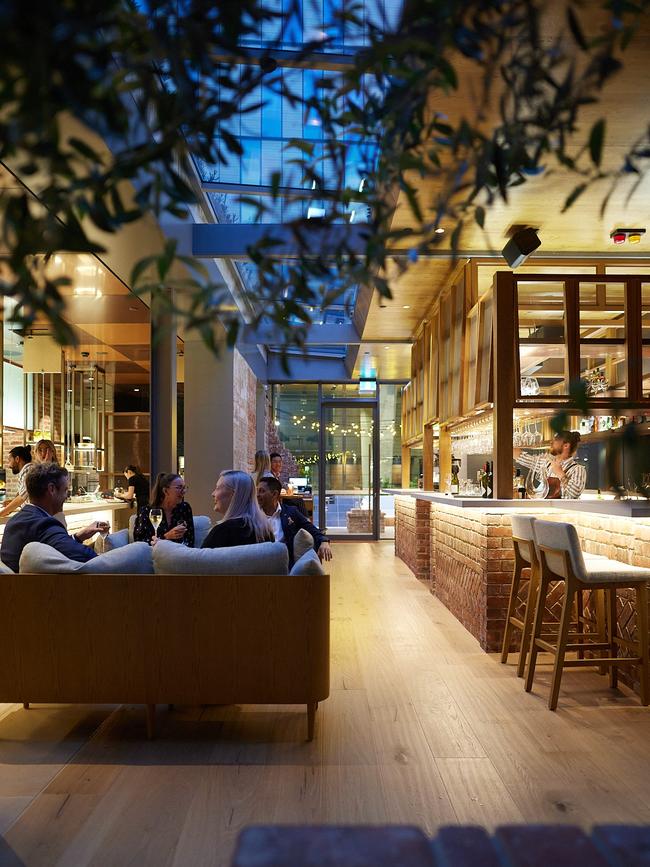
The Tasman is the global Marriott group’s only ultra-prestige luxury collection property in Australasia and the scale of the project, its ambition and sensitivity, is impressive. It’s the work of Sydney studio Francis-Jones Morehen Thor – the firm behind the 2013 world building of the year, Auckland Art Gallery – with interiors in the rooms and public areas by another Sydney practice, Joseph Pang Design Consultants. Mary Mary and the other food and drink venues are by Michael McCann from Dreamtime.
Working in concert, the three design firms managed to harmonise the 1840s early colonial crust with former lives as a hospital and a titles office, the Gothic revival facade, a bold 1940s Art Deco corner block and a new glass-shard structure with retail space on the ground floor and hotel suites above, and to link these disparate elements and eras with sinews of contemporary concrete, steel and glass.
The hotel is a design lover’s delight, a Tasmanian architectural microcosm. The heritage wing recalls the stretches of Georgian architecture preserved in Hobart and the near-intact Midlands towns of Oatlands and Ross. Its fanciful façade points to the Gothic revival of the island’s many churches: Tasmania even has synagogues in the rare Egyptian-revival style. And the hotel’s wraparound Art-Deco corner façade chimes with the textbook examples of the period in The Mercury Building and the former Hydro-Electric Commission HQ.
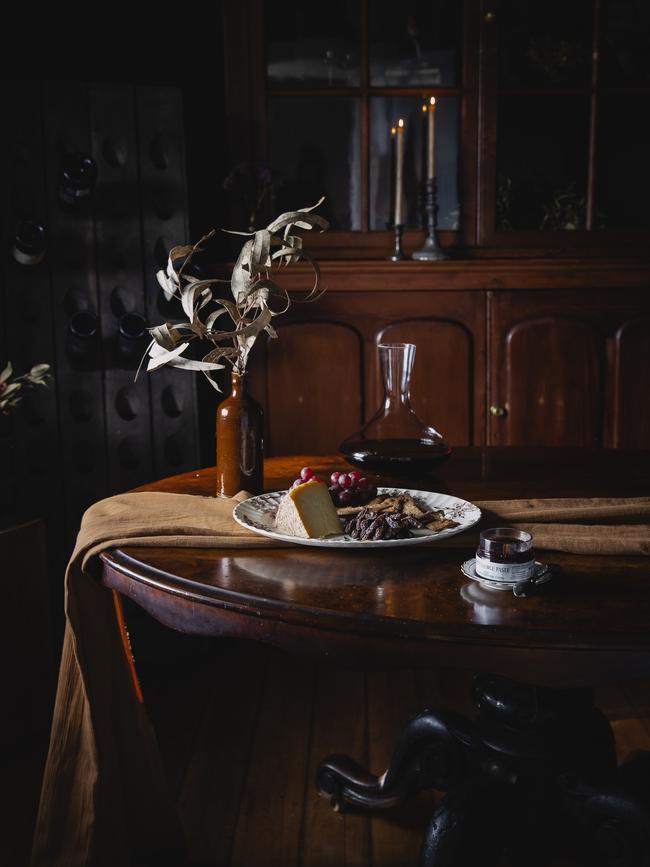
The aim was to create a “very Tasmanian” expression of luxury, says marketing manager Sarah Thomas. “The respect for heritage, beautiful details in textures and timber, and unique collaborations with local makers all contribute to a unique, relaxed expression of exclusivity,” she says.
Setting the tone, in the hotel foyer, is an untitled Huon Pine sculpture by local designer Nick Randall, which I take to be a riff on an emu’s coat. In fact it’s all about boats, currents and waves: a suitably maritime emblem for a town whose history – indigenous and European – is intimately entwined with the sea.
Most of the hotel’s 152 rooms are designed around original features, which means few are the same. Our room has towering four-metre ceilings and the uncommon luxury of a working fireplace (albeit gas fuelled). One suite has a carved timber bathtub, another a ceiling panel of rare blackheart sassafras. Produce at Peppina, the courtyard brasserie designed around sandstone and old brick walls, a pair of fully grown olive trees and an open kitchen, is resolutely local and seasonal. Everything from beer to bathroom products to a Lark-distilled special-edition single malt celebrate the island’s produce and craft traditions.
Mary Mary is on the ground floor of what was once St Mary’s Hospital. The head barman, Dublin-born Ronan Kavanagh, jokes to customers with robust constitutions that a section of the bar was once the hospital morgue. He’s even contemplating a new cocktail named Rigor Mortis in its honour. “It’d have to be a stiff drink, for sure,” he quips. “Maybe a mix of navy strength gin and absinthe.”
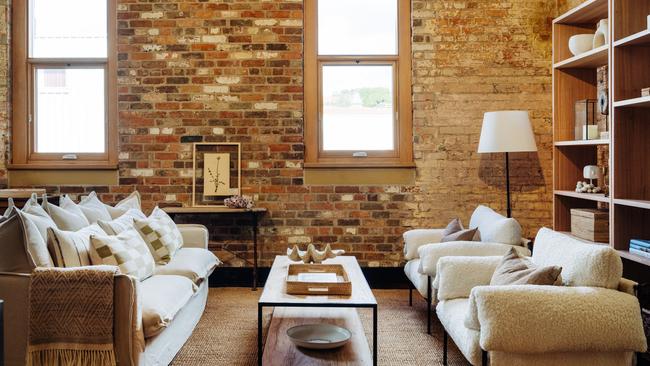
Timber salvaged from the old hospital has been transformed into a gleaming parquetry floor, and a wall of solid steel strong-doors faces a wall of wheaten-hued sandstone for muscular effect. The bar and banquettes are faced in honeyed leather, the mid-century chairs are upholstered in burnt orange velvet. Theatrical downlights turn round marble tables into glowing full moons. At night, the low-ceilinged, low-lit room blends shadow, glowing amber and smouldering brown – Rembrandt colours.
“Everything we pour here has a story and means something to us,” says Kavanagh, who takes the standards seriously. He pours a textbook dirty martini, but also weaves flights of Van Demonian fancy around his cocktails. Kavanagh’s True Local is a personal expression of Tasmanian-ism: Charles Oates apple brandy, which Kavanagh had a hand in as the former head distiller at the Huon Valley ciderie Willie Smith’s, a raspberry aperitif by Hobart-based 7K Spirits, vermouth by Hughes and Hughes born out of the 2019 bushfires, and fresh heirloom apple juice from an orchardist friend in Geeveston.
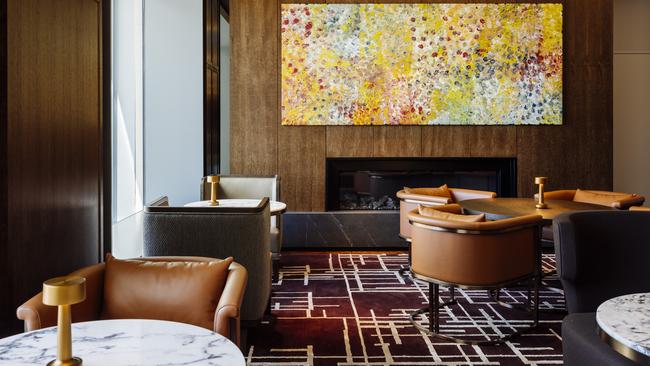
The opening of The Tasman is a timely reminder that while wilderness and wombats are good reasons to cross Bass Strait, so too are heritage towns, innovative design and atmospheric streetscapes. The built environment of Tasmania is as unique, in its way, as the natural one.
On a different scale entirely, another Hobart CBD project offers travellers the choice of clever heritage conversions or sleek contemporary apartments, side by side. The Rox, by local architecture practice Core Collective, occupies an urban precinct much loved by locals and visitors with inside knowledge. Core Collective, joint winner in the heritage section of the 2020 National Australian Awards, has designed a sculptural four-storey corner apartment block that gives onto a small triangular forecourt plus two heritage apartments reclaimed from the 1880s Scotch College. In front, on Elizabeth Street, stands the Italianate Roxburgh House from the same era.
The corner curves of the new off-white Rox apartments riff on the city’s Art Deco heritage, and lime mortar bagging softens the brickwork. The building seems at home in its environment, but not beholden to it. It’s a bold project, a dream of elsewhere – the Mediterranean, perhaps.
Old and new, both apartments have loads of character and share a killer location. From its huge fourth-storey terrace, the two-bedroom penthouse has a view straight down Elizabeth Street to a framed scene of harbourfront blue. Across the alley, an old classroom-turned vacuum-cleaner warehouse has been converted into a chic apartment with rustic exposed brickwork, original floorboards, and an inventive use of space that floats two bedrooms in a mezzanine level above a sleek kitchen.

A big draw at The Rox is the neighbourhood, a strip of quirky boutiques and studios, including a CWA gift shop, a knife shop, an izakaya and several sharp barbershops. Chief among them is Sonny, a wildly popular hallway-sized wine bar with the mood of a Hobartian house party. Cleverly, The Rox has arranged exclusive room service from Sonny’s tiny kitchen, which guarantees a dose of Sonny sunniness without the block-long queue for one of just 20 seats.
There’s a knock at the door and Sonny’s chef and owner Matt Breen arrives with an armful of gleaming tiffin boxes and a bottle of Pooley pinot noir. “This is basically the entire menu tonight,” he grins, untethering the tiffins and talking us through a constellation of superior bar snacks and small plates. There’s fresh sourdough from Dino the Bread Guy with Mount Zero olives and smoked almonds; local oysters; and moreish prosciutto toast with anchovies and chilli, a Sonny signature. The next tiffin tranche holds beef tartare from the butcher at Huon Valley Meat Co; house-made spaghetti verde topped with pangrattato, market-fresh cucumbers and stracciatella under a drift of fresh hazelnuts; and for dessert, Tongola fresh goat’s cheese from Marion Bay with a drizzle of leatherwood honey. The only thing missing is Al the always beaming Sonny barman spinning his mood-enhancing vinyl collection.
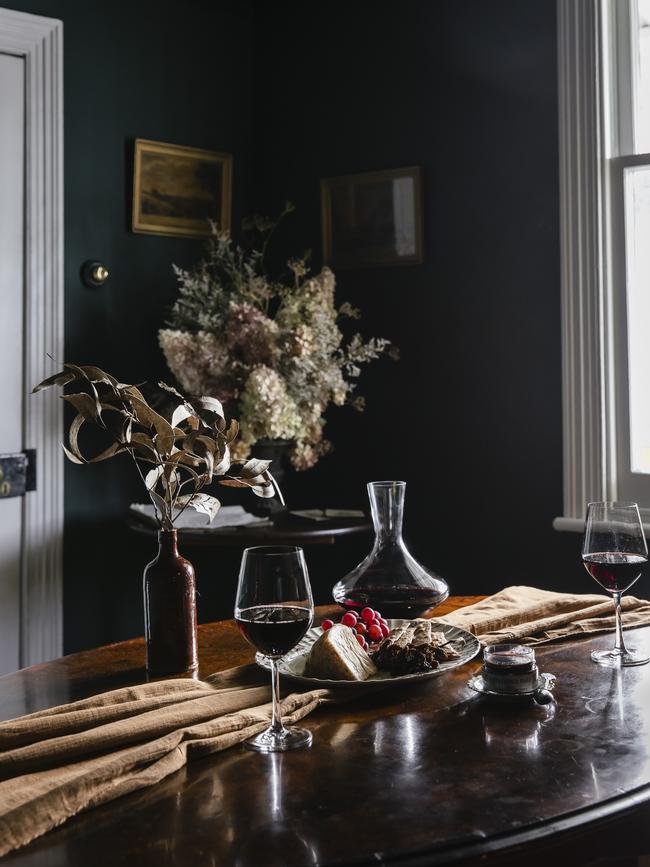
From inner city to inner suburban, a third new stay offers a live-like-a-local ambience in West Hobart, on a leafy street lined with gentrified cottages. Lumiere Lodge, a romantic Victorian-era weatherboard, has been given an inspirational makeover defined by canny antique fossicking, impressive restoration of original fireplaces and timber, and a penchant for fine linen, old china and covetable homewares. Many of the quirky colonial artworks and furnishings are one-of-a-kind antique shop acquisitions and they impart to the cottage a dream-like air of mystery.
At the heart of Lumiere Lodge is a large country kitchen filled with leaf-green light filtered through a courtyard garden. With a fully kitted kitchen and the popular Hill Street Grocer walking distance away, Lumiere is perfectly set up for entertaining. Last winter I sat down at its long antique dining table with 20 guests for dinner prepared by local chefs Luke Burgess and Lilly Trewartha. This summer I reeled in some friends. We opened a few bottles of Tasmanian fizz and sat in the courtyard to enjoy the lingering midsummer “lumiere” at 42 degrees south – aka twilight. I could smell the cooling evening air from Mount Knocklofty nearby, and the vast Southwest wilderness beyond.
The Tasman, marriott.com/en-us/hotels/hbalc-the-tasman-a-luxury-collection-hotel-hobart/overview/
The Rox, theroxhobart.com
Lumiere Lodge, lumierelodge.com/thespace

To join the conversation, please log in. Don't have an account? Register
Join the conversation, you are commenting as Logout